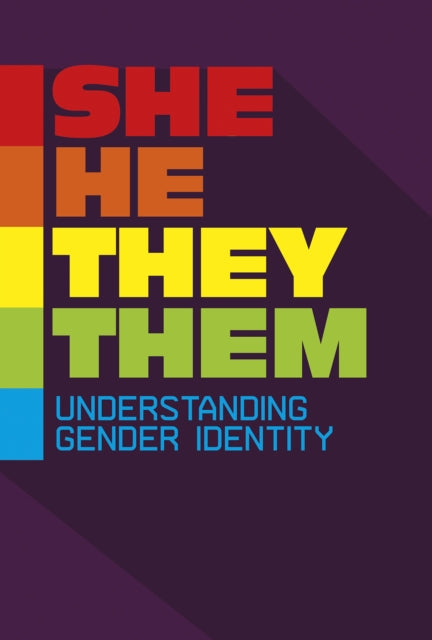Rebecca Stanborough
She/He/They/Them: Understanding Gender Identity
She/He/They/Them: Understanding Gender Identity
YOU SAVE £2.86
- Condition: Brand new
- UK Delivery times: Usually arrives within 2 - 3 working days
- UK Shipping: Fee starts at £2.39. Subject to product weight & dimension
Bulk ordering. Want 15 or more copies? Get a personalised quote and bigger discounts. Learn more about bulk orders.
Couldn't load pickup availability
- More about She/He/They/Them: Understanding Gender Identity
Gender pronouns are used to refer to a person's gender identity, and some people prefer to be referred to as they/them. Gender identity is a person's sense of their own gender. Students will learn about these terms and their reasons, and how to deal with questions about gender identity.
Format: Paperback / softback
Length: 64 pages
Publication date: 04 March 2021
Publisher: Capstone Global Library Ltd
Why do we use gender pronouns?
The use of gender pronouns is a complex and multifaceted issue that has been the subject of much debate and discussion in recent years. Gender pronouns are words or phrases that are used to refer to a person's gender identity, which is the internal sense of being male, female, non-binary, or genderqueer.
There are several reasons why we use gender pronouns. One of the primary reasons is to respect a person's gender identity. When we use the correct gender pronouns for a person, we are affirming their identity and showing that we recognize and respect their gender expression. This is important for creating a safe and inclusive environment for all individuals, regardless of their gender identity.
Another reason why we use gender pronouns is to avoid misgendering or misidentifying a person. Misgendering is when a person is referred to by a gender pronoun that does not match their gender identity. This can be harmful and offensive to a person, and can lead to feelings of distress, anxiety, and marginalization. By using the correct gender pronouns, we can help to prevent misgendering and create a more respectful and inclusive environment.
In addition to these reasons, there are also cultural and social factors that influence the use of gender pronouns. In some cultures, gender pronouns are used to indicate a person's social status or role in society. For example, in some indigenous cultures, gender pronouns are used to indicate a person's gender role and relationship to others in the community. In other cultures, gender pronouns may be used to express a person's gender identity in a way that is different from the gender they were assigned at birth.
Despite the importance of using gender pronouns, there are also some individuals who do not wish to be referred to as they or by gender pronouns at all. These individuals may identify as genderqueer, non-binary, or gender non-conforming, and may prefer to be referred to by other pronouns or by gender-neutral terms.
Gender identity is a complex and multifaceted concept that refers to a person's internal sense of their gender identity. It can be influenced by a variety of factors, including genetics, socialization, and personal experiences. Gender identity can be binary, meaning a person identifies as male or female, or non-binary, meaning a person identifies as neither male nor female, or genderqueer, meaning a person identifies as a combination of male, female, or other gender expressions.
Individuals who identify as genderqueer, non-binary, or gender non-conforming may experience discrimination, marginalization, and violence because of their gender identity. This can lead to feelings of isolation, anxiety, and depression, and can impact a person's ability to access healthcare, education, and employment.
To support individuals who identify as genderqueer, non-binary, or gender non-conforming, it is important to create a safe and inclusive environment that recognizes and respects their gender identity. This can include using the correct gender pronouns, providing access to healthcare and support services, and promoting education and awareness about gender identity.
In conclusion, the use of gender pronoun and gender identity is a complex and multifaceted issue that requires careful consideration and respect for all individuals. By using the correct gender pronouns, avoiding misgendering or misidentifying a person, and creating a safe and inclusive environment, we can help to promote gender equality and create a more respectful and inclusive society for all individuals.
Weight: 128g
Dimension: 228 x 147 x 7 (mm)
ISBN-13: 9781474794305
This item can be found in:
UK and International shipping information
UK and International shipping information
UK Delivery and returns information:
- Delivery within 2 - 3 days when ordering in the UK.
- Shipping fee for UK customers from £2.39. Fully tracked shipping service available.
- Returns policy: Return within 30 days of receipt for full refund.
International deliveries:
Shulph Ink now ships to Australia, Belgium, Canada, France, Germany, Ireland, Italy, India, Luxembourg Saudi Arabia, Singapore, Spain, Netherlands, New Zealand, United Arab Emirates, United States of America.
- Delivery times: within 5 - 10 days for international orders.
- Shipping fee: charges vary for overseas orders. Only tracked services are available for most international orders. Some countries have untracked shipping options.
- Customs charges: If ordering to addresses outside the United Kingdom, you may or may not incur additional customs and duties fees during local delivery.


